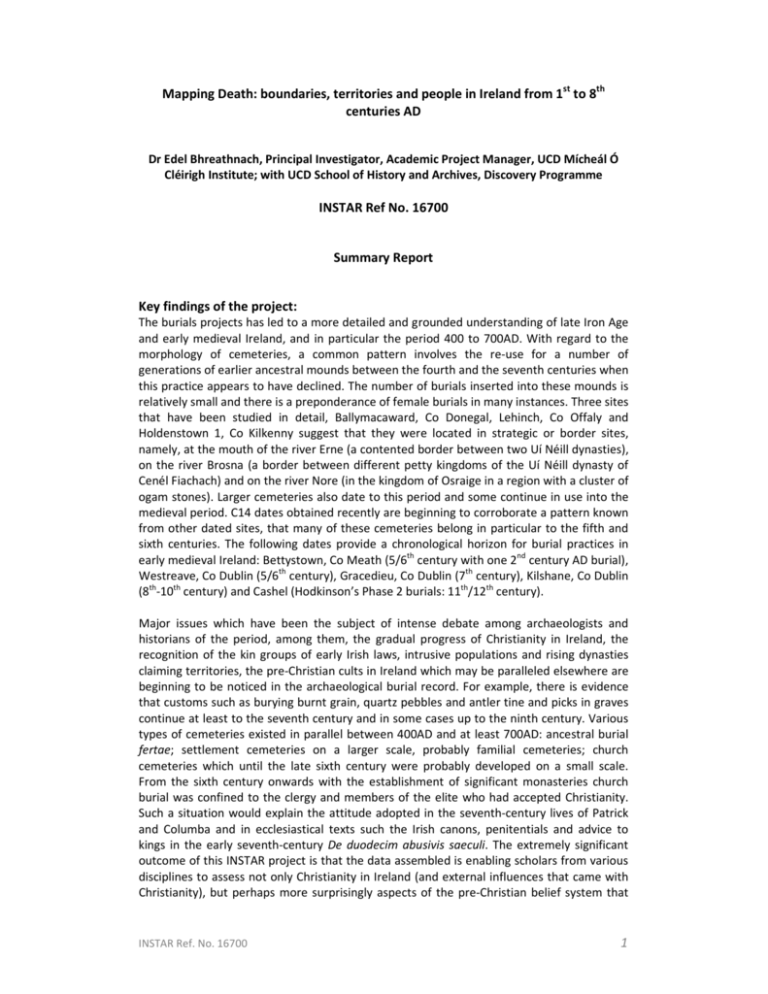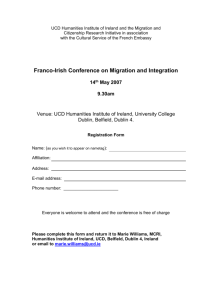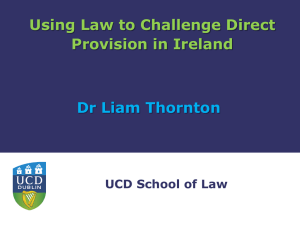1 Mapping Death: boundaries, territories and people in Ireland from
advertisement

Mapping Death: boundaries, territories and people in Ireland from 1st to 8th centuries AD Dr Edel Bhreathnach, Principal Investigator, Academic Project Manager, UCD Mícheál Ó Cléirigh Institute; with UCD School of History and Archives, Discovery Programme INSTAR Ref No. 16700 Summary Report Key findings of the project: The burials projects has led to a more detailed and grounded understanding of late Iron Age and early medieval Ireland, and in particular the period 400 to 700AD. With regard to the morphology of cemeteries, a common pattern involves the re-use for a number of generations of earlier ancestral mounds between the fourth and the seventh centuries when this practice appears to have declined. The number of burials inserted into these mounds is relatively small and there is a preponderance of female burials in many instances. Three sites that have been studied in detail, Ballymacaward, Co Donegal, Lehinch, Co Offaly and Holdenstown 1, Co Kilkenny suggest that they were located in strategic or border sites, namely, at the mouth of the river Erne (a contented border between two Uí Néill dynasties), on the river Brosna (a border between different petty kingdoms of the Uí Néill dynasty of Cenél Fiachach) and on the river Nore (in the kingdom of Osraige in a region with a cluster of ogam stones). Larger cemeteries also date to this period and some continue in use into the medieval period. C14 dates obtained recently are beginning to corroborate a pattern known from other dated sites, that many of these cemeteries belong in particular to the fifth and sixth centuries. The following dates provide a chronological horizon for burial practices in early medieval Ireland: Bettystown, Co Meath (5/6th century with one 2nd century AD burial), Westreave, Co Dublin (5/6th century), Gracedieu, Co Dublin (7th century), Kilshane, Co Dublin (8th-10th century) and Cashel (Hodkinson’s Phase 2 burials: 11th/12th century). Major issues which have been the subject of intense debate among archaeologists and historians of the period, among them, the gradual progress of Christianity in Ireland, the recognition of the kin groups of early Irish laws, intrusive populations and rising dynasties claiming territories, the pre-Christian cults in Ireland which may be paralleled elsewhere are beginning to be noticed in the archaeological burial record. For example, there is evidence that customs such as burying burnt grain, quartz pebbles and antler tine and picks in graves continue at least to the seventh century and in some cases up to the ninth century. Various types of cemeteries existed in parallel between 400AD and at least 700AD: ancestral burial fertae; settlement cemeteries on a larger scale, probably familial cemeteries; church cemeteries which until the late sixth century were probably developed on a small scale. From the sixth century onwards with the establishment of significant monasteries church burial was confined to the clergy and members of the elite who had accepted Christianity. Such a situation would explain the attitude adopted in the seventh-century lives of Patrick and Columba and in ecclesiastical texts such the Irish canons, penitentials and advice to kings in the early seventh-century De duodecim abusivis saeculi. The extremely significant outcome of this INSTAR project is that the data assembled is enabling scholars from various disciplines to assess not only Christianity in Ireland (and external influences that came with Christianity), but perhaps more surprisingly aspects of the pre-Christian belief system that INSTAR Ref. No. 16700 1 pertained in Ireland on the arrival of Christianity. It is cleat that detailed scrutiny of the data will allow for new interpretations of early Irish and Hiberno-Latin literature and for a rewriting of the history of Ireland, 400-700AD. Dissemination: Lectures and conferences 10 March 2009: Dr Michael Potterton and Ms Michael Ann Bevivino spoke to the Archaeology Society in NUI Galway about the ‘Mapping Death’ project. 17-19 April 2009: Roscrea Spring Conference. Drs Edel Bhreathnach and Elizabeth O’Brien delivered papers on topics covered by the ‘Mapping Death’ project. 12-14 June 2009: ‘Landscapes of cult and kingship: archaeology and text’ NUI Galway. Dr Edel Bhreathnach delivered a paper on the importance of pre-12th century Cashel. 17-21 August 2009: Rathmichael Historical Society 35th Summer Series ‘The pagan to Christian transitional period in Ireland’, organised by Dr Elizabeth O’Brien and the Rathmichael Committee. Papers were delivered by Drs Bhreathnach, Johnston and O’Brien and by Charles Doherty (UCD) and Elizabeth Dawson (UCD). 4 November 2009: Insular Studies seminar, University College Cork. Dr O’Brien delivered a public lecture outlining burial practices in Ireland from the 4th to the 8th centuries AD. 27/28 November 2009 ‘Mapping Death: People, boundaries and territories in Ireland 1st to 8th centuries AD’: a two-day conference held in the Royal Society of Antiquaries of Ireland attended by approximately 100 people at which 23 papers were delivered on a wide range of aspects of the topic. The outcome of this conference will form the basis for discussions on the shape of a major publication in 2010/11. Publications Contributions describing the ‘Mapping Death’ project were made to the Newsletter of the Society for Medieval Archaeology and UCD Today and TEA: The European Archaeologist. Dr O’Brien’s important article ‘Pagan or Christian? Burial in Ireland during the 5th to 8th centuries AD’ has been published in the volume The archaeology of early medieval Celtic churches edited by Nancy Edwards (Society for medieval archaeology monographs, 2009). The volume Death and Burial in Early Medieval Ireland in light of recent archaeological investigations, edited by Michael Potterton & Christiaan Corlett (with a foreword by Dr O’Brien and contribution by Dr Bhreathnach) is currently in press (Wordwell Books). The project’s website is www.mappingdeath.ie. INSTAR Ref. No. 16700 2







